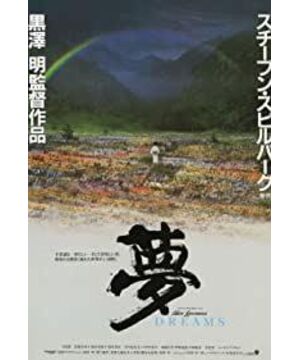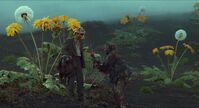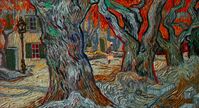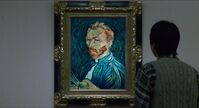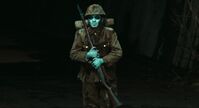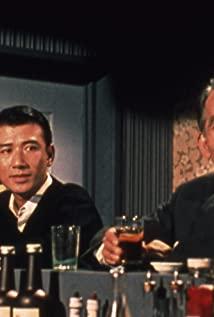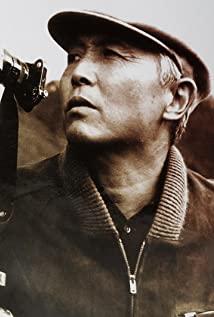In 1990, the 80-year-old Kurosawa, with the help of his admirers on the other side of the ocean, used film extravagantly to make a two-hour dream, which also achieved one of the most infectious and Ambitious dreams.
Sun Rain, Taoyuan, Snowstorm, Tunnels, Crows, Red Mount Fuji, Weeping Devil and Waterwheel Village. Eight prose-like paragraphs, fragmented, messy, and shocking, cover war and society, nature and life. In the overall structure of the story, they have completely separated from the plot factors and turned into deep thinking about life. The different worlds in the dream are expressed using a large number of long shots and excellent visual effects. All the dreams seem to exhibit themes of human loss and uncertainty, but are themselves filled with a hopeless nostalgia.
The curious little boy in the sun rain
disobeyed his mother's advice, ran into the woods when the sun was raining, and bumped into the fox's wedding that he shouldn't have seen. The strange pace of the foxes in the woods is hilarious and impressive.
The little boy ran home in clogs. The sun had stopped raining, but his mother was paranoid about not letting him in. She took out a knife from the fox and told him that the fox wanted him to apologize with the heart of death.
A beautiful rainbow appeared in the sky after the rain, and the foxes lived on the other side of the rainbow. So the little boy ran into the sea of flowers in the valley, looked up and saw the rainbow.
I have always been fascinated by the beautiful field scenery in the film, the misty fog in the forest, the unrealistic raindrops reflecting the sun's rays, the mysterious and quite traditional Japanese ritual beauty, the family under the rainbow, and the legend of the fox marrying a daughter. It was a grotesque, funny, romantic, disturbing and unreasonable dream.
Peach orchard
March 3, Peach Blossom Festival. The little boy's family cut down all the peach trees, and only one survived. Flowers are full of flowers during the Girls' Day, and young children hear Xuanyin. The little boy ran out with the figure. The figure is the elf of the peach tree, she led the boy to the peach forest to listen to the complaints of the peach tree family. The mysterious and elegant artistic conception and the imagination of the child's feelings will make people inadvertently infected. Akira Kurosawa's rich imagination is evident from this. He combined puppets with Noh and Noh, and imagined Taolin as a young altar, creating a scene with a very Japanese flavor, which also showed his nostalgia for and yearning for Japanese traditional culture. The image of the young man should be a prophet, only he saw the daughter of the peach tree, he wanted to tell others, but the people around him turned a blind eye. He was in pain because he wanted to keep the full spring, but he couldn't stop people from cutting down the peach forest; he dreamed that the peach blossoms were in full bloom, and when he opened his eyes, what he saw was a broken arm and stubble... This is the trouble of the prophet, and it is also a human being Total sin! So the boy cried, and it was also Kurosawa Akira's tears. The old man hopes that the young man can represent the new generation of mankind, no longer ignore nature, can cherish them, and prevent the beautiful nature from disappearing around him...
The crow
should be more precisely a dream about Van Gogh. This is probably a dream that many people like.
A Japanese young man who symbolized Kurosawa himself was watching Van Gogh's painting exhibition in the gallery, and suddenly walked into one of Van Gogh's paintings: Aer's suspension bridge, carriage, wheat field, the washerwoman beside... The peasant women answered the young Van Gogh. Gao's whereabouts, and laughed loudly to remind him to be careful of Van Gogh who just came out of the mental hospital.
In the shot, the vast and boundless golden-yellow wheat, the green grassy slopes, and the bright and dazzling flowers on the roadside are as intense and intense as in oil paintings. In a large field of newly harvested wheat, a person is painting with a brush. . Van Gogh, who had a bandage on his head, asked the young man why he didn't paint. Without waiting for an answer, he said that nature is beautiful, so there's no need to look for it, just keep painting. After a few simple questions, Van Gogh looked at the sun and said that the time to paint was running out, so he took up his bag and picture clip and left.
Young people shuttle in Yangguan-like passion, rich and colorful colors, everything is Van Gogh's world. Finally, I found the figure of Van Gogh in the path of the wheat field. At this time, the crows flew up, all over the sky, and Van Gogh also turned into a black spot in the distance and disappeared.
In the final shot, the young man takes off his hat - a dream of the master paying homage to the master.
This is a dream about art. Van Gogh itself is a dream of Akira Kurosawa, simple, clean, and lonely, so much that he wants to pursue him in the dream. Van Gogh's oil paintings have a unique magical tension, wild and restrained colors, entangled on the canvas, all of which are ready to show power. Akira Kurosawa's interpretation made Van Gogh's paintings "moving", and the scene almost identical to the original paintings made those oil paintings suddenly come alive, and even we can walk in and walk between the past and the reality, the real and the unreal , visiting and asking between real scenes and paintings, between reality and imagination.
The last dream of the eight dreams of the Watermill Village
, a dream of returning to nature, a life wish of returning to nature. Xanadu. Beautiful and infectious.
Under the sun, there was a small wooden bridge, a clear stream, and many waterwheels were turning by the stream. Several children came over to pick some flowers and put them on a stone on the bank. This is the tomb of a wanderer, many young people do not know the story, but have become accustomed to it.
Young people are chatting with a 103-year-old man. The old man said that this village has no name, they all call it the village, and others call it the Waterwheel Village. The village has no electricity, no harvesters, branches for lighting, cow dung for fuel, and cattle and horses for farming.
The old man was about to attend the funeral. "This 99-year-old old woman was my first love. She abandoned me and married someone else." After the old man finished speaking, he laughed.
On the village road, the funeral procession came. Children were at the head of the line. They threw flower petals into the air. Men played musical instruments. Older women beat drums and bells. Around the coffins they were carrying were young girls. They wear straw hats with bunches of flowers and dance to the beat. The music and dancing are simple and cheerful. The old man dressed in red, waving bells and flowers, went to the front of the line. It seems more like a celebration.
As the procession passed, the stream was quiet, and the young people also broke branches and flowers and placed them on the rocks by the stream.
The sound of the waterwheel, the water plants swayed gently on the bottom of the water.
The hustle and bustle returned to tranquility, and in the twilight years, the master's heart was also at peace. Akira Kurosawa left us a picture of the paradise-like life in the waterwheel village, and also gave him a comfort. Through the mouth of the centenarian man in red, he said, "I don't need a light so bright that even the stars can't be seen." "It's a very gratifying thing for people to perform their duties well in this world and then die with a clear conscience. "Some people say that life is hard, and they have no intentions. In fact, life is so good and life is wonderful." Then the master went with his dream, but gave us living people a huge dilemma: modern society, The inflated desire blurs our principles and chaotic our sight. Where else can we find such a paradise with few desires? Even if there is, in such pastoral fields, how can we survive in modern times?
...
I prefer these four dreams, which are relatively brighter and more beautiful, and there are four other dreams, which I also like, but they are heavier and more depressing. Although it is director Kurosawa's "Dream", although there are many imaginary stories in "Dream", although the colors of "Dream" are constantly changing, the picture is always like an oil painting, sometimes it is like reality, sometimes it is Hazy like poetry, there is no illusory, ethereal and unreal feeling, but solemn and thick. It can be seen that Akira Kurosawa often treats and thinks about life with this attitude. "Dream" is the dream of a person who has experienced ups and downs. It belongs to Akira Kurosawa's own dream, a dream from childhood to old age, different dreams in different periods. The shooting method did not deliberately pursue highly technical flashback shots, fast and slow shots... nor did it find novel and unique angles, twists and turns and blurred plots, just like treating an oil painting seriously and earnestly typing, online, and color enhancement , over and over again, this may be his artistic pursuit at such an age. Nevertheless, in that world full of colors, we can still feel the heart of innovation and change.
Akira Kurosawa's "Dream" is enough to make viewers unforgettable for a long time. From this, we are more like looking at the persistence of an old man's life. Kurosawa said, "In this film, I include all my views on today's society... Now the beautiful nature is disappearing... At the same time, of course, the beautiful human mind will also disappear. I just want to describe naturally. My nostalgia for nature and the beautiful mind."
View more about Dreams reviews


